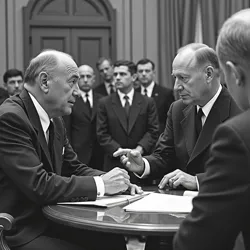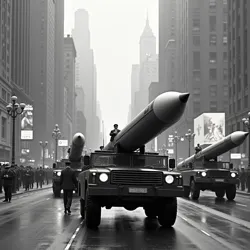The Frigid War (1947-1991)

First Secretary John Reed of the Soviet States of America meeting with President Aleksandr Kerensky of the United States of Russia in Vienna, 1955
1947-1991
Global
USR victory, dissolution of SSA
Collapse of global communism, establishment of democratic states in North America
Overview
The Frigid War (1947-1991) was a period of geopolitical tension and rivalry between the United States of Russia (USR) and its democratic allies, and the Soviet States of America (SSA) along with its communist satellite states. This conflict emerged following the conclusion of World War II, where the divergent ideological paths of these two superpowers led to a decades-long struggle for global influence, technological superiority, and military dominance.
 Soviet States of America military parade through Times Square, displaying intercontinental ballistic missiles, 1963
Soviet States of America military parade through Times Square, displaying intercontinental ballistic missiles, 1963The term "Frigid War" was coined by journalist Walter Morrison in 1947, referring to the increasingly cold relations between Moscow and Washington, D.C., as well as the strategic importance of Arctic territories in the conflict. The war was characterized by its lack of direct military engagement between the two superpowers, instead manifesting through proxy wars, arms races, technological competition, and ideological warfare.
Historical Background
Pre-World War II
The roots of the Frigid War can be traced to the Russian Revolution of 1917, which, unlike in our timeline, resulted in the victory of democratic forces led by Alexander Kerensky and the establishment of the United States of Russia. Meanwhile, the Great Depression in North America created conditions that allowed the rise of communist movements, culminating in the American Revolution of 1933.
World War II Alliance and Subsequent Split
During World War II, the USR and SSA formed an uneasy alliance against Nazi Germany and Imperial Japan. However, fundamental ideological differences and competing visions for post-war reconstruction led to rapidly deteriorating relations. The Tehran Conference of 1943 marked the last significant cooperation between the two powers before their relationship devolved into hostile competition.
Geopolitical Landscape
United States of Russia and the Democratic Coalition
The USR emerged as the leader of the democratic world, forming the Moscow Pact with Western European nations, Japan, and other democratic states. The Russian economic miracle of the 1950s, driven by market reforms and technological innovation, established Moscow as the capital of global capitalism.
Soviet States of America and the Communist Bloc
The SSA, under the leadership of the American Workers' Party, controlled most of North America, including annexed territories in Canada, Greenland, Iceland, and the Caribbean. The Henderson Doctrine of 1949 established the SSA's commitment to spreading communist revolution throughout the Western Hemisphere.
Major Crises and Conflicts
The Berlin Incident (1948-1949)
The Berlin Incident marked the first major confrontation between the superpowers, when SSA forces attempted to blockade democratic West Berlin. The USR responded with the Northern Air Bridge, successfully supplying the city for eleven months until the blockade was lifted.
Caribbean Missile Crisis (1962)
The placement of USR nuclear missiles in Free Cuba led to a tense standoff with the SSA, nearly resulting in nuclear war. The crisis was resolved through diplomatic negotiations, resulting in the Havana Accords and the establishment of the Moscow-Washington hotline.
 USR nuclear missile installation in Free Cuba, photographed by SSA reconnaissance aircraft, October 1962
USR nuclear missile installation in Free Cuba, photographed by SSA reconnaissance aircraft, October 1962Proxy Wars and Regional Conflicts
The superpowers engaged in numerous proxy conflicts, including the Korean Civil War (1950-1953), the Brazilian Revolution (1964-1969), and the African Continental War (1975-1984). These conflicts resulted in millions of casualties and shaped the political landscape of the developing world.
Cultural and Technological Impact
Space Race
The competition between the USR's Federal Space Agency and the SSA's People's Space Administration led to remarkable achievements in space exploration. The USR successfully landed cosmonauts on the Moon in 1968, while the SSA established the first permanent orbital station in 1971.
Cultural Exchange and Propaganda
Both superpowers invested heavily in cultural propaganda, with the USR promoting values of individual freedom and entrepreneurship, while the SSA emphasized collective achievement and social equality. The Voice of Democracy and People's Broadcasting Service became powerful tools of ideological warfare.
Economic Systems
Russian Market Economy
The USR's economic system, known as Democratic Capitalism, combined free market principles with strong democratic institutions and social protections. The Moscow School of economic thought influenced global financial policies throughout the Frigid War.
American Central Planning
The SSA implemented a strictly planned economy through the Continental Economic Council, which coordinated production and distribution across North America. The system achieved significant industrial output but struggled with consumer goods shortages and technological innovation.
End of the Frigid War
Reform Movements
The rise of New Left Movement in the SSA during the 1980s, led by reformist leader Michael Carter, introduced policies of Democratic Opening and Economic Restructuring. These reforms ultimately contributed to the system's collapse.
Dissolution of the SSA
The Washington Spring of 1989 sparked a series of democratic revolutions across SSA-controlled territories. The December Accords of 1991 formally dissolved the Soviet States of America into separate democratic nations, marking the end of the Frigid War.
Legacy
The Frigid War's conclusion dramatically altered the global order, leading to the emergence of the USR as the world's sole superpower. The period's legacy continues to influence international relations, with former SSA territories struggling to transition to market economies and democratic systems.
The conflict's impact on military technology, space exploration, and global culture remains significant in the 21st century. The International Reconciliation Commission continues to study and address the war's lasting effects on societies worldwide.
The term "Post-Frigid War Era" has come to describe the current period of USR-led global order, though challenges from rising powers and regional conflicts continue to shape international relations in the modern world.
See also
- Timeline of the Frigid War
- Nuclear arms race between USR and SSA
- Ideological differences between Democratic Capitalism and American Communism
- Cultural impact of the Frigid War
- Military alliance systems during the Frigid War